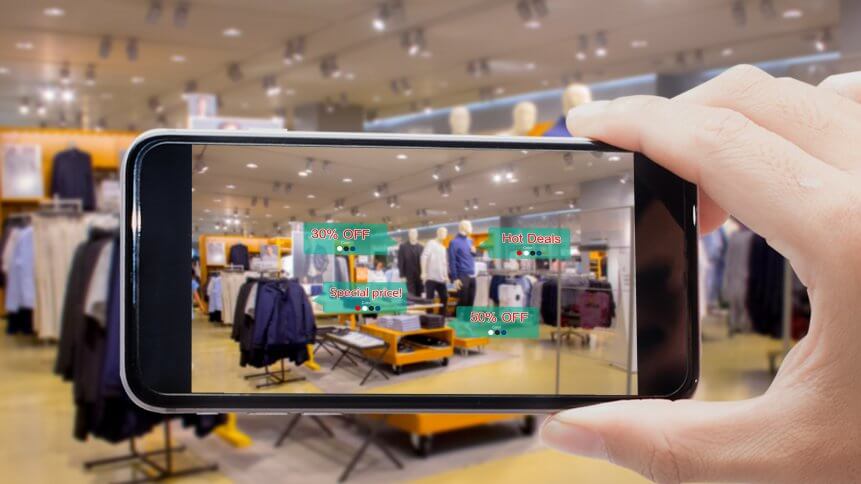Five trends driving e-commerce and breaking new boundaries

E-commerce is a restless beast, forever evolving and changing shape. Here are the five trends that are dominating the digital realm this year.
# 1 | Interactive product visualization
One of the biggest roadblocks to e-commerce growth, across retail segments such as fashion, homeware, and luxury goods, is that websites and apps don’t offer the same sensory cues as physical shopping. This creates a significant level of anxiety for consumers and is a major contributing factor to basket abandonment.
Once retailers could only offer high-quality images of products, but today’s technology enables them to use virtual reality, 3D imaging, augmented reality, and more. This means shoppers can interact with products online like never before. For example, they can use their smartphone to place a virtual television in their sitting room to see how it would look or try on a virtual shoe.
# 2 | B2B e-commerce is exploding
Who said e-commerce was only for B2C brands? B2B companies are leveraging upcoming trends, too, enjoying all the benefits pioneered by the B2C sector. It’s been projected that B2B e-commerce sales will increase worldwide to US$6.6 trillion by 2020. A recent survey of 500 B2B organizations found that 80 percent accepted orders and payment via their website.
E-commerce boosts B2B sales by tapping more business opportunities as it strengthens online presence, harnesses SEO and means customers from further afield can access goods for sale.
Unsurprisingly, e-commerce personalization is also a crucial element for B2B shoppers with research showing that 50 percent of B2B buyers wanted personalization when searching for online suppliers. The good news for businesses is that they can benefit from the work being done in the B2C world by applying personalization to opt-in emails, transactional emails, personalized website landing pages, social media, wishlists and loyalty programs, to name just a few.
A great B2B e-commerce platform also lets you streamline and automate repetitive processes and provide data-driven insights into your sales and marketing operations, especially when a platform is integrated with an ERP system.
YOU MIGHT LIKE

How pop up retail will revitalize physical commerce
# 3 | Conversational commerce – the rise of chatbots 2.0
2019 is the year that conversational commerce finally goes mainstream, according to Gita Samani, Digital Consultant at Astound Commerce.
Thanks to consumers’ adoption of messenger apps such as Whatsapp and Facebook Messenger for social use, the switch from chatting with friends and family to discussing purchases with brands is natural, she says.
Until recently the main barrier to widescale chatbot use has been the technology. Attempts at automated chat have often been clunky, hampered by limited natural language processing (NLP) technology. Only recently has NLP, and specifically, deep learning, evolved sufficiently to deliver a natural customer interface that is much more intuitive, and easy to understand.
# 4 | Conversational commerce – virtual digital assistants
While chatbots have been with us for a while, virtual digital assistants as a sales channel is still an emerging trend. The catalyst for this is the growing ubiquity of domestic devices that support Google Assistant, Amazon’s Alexa and Apple’s Siri.
Amazon claims it shipped ‘tens of millions’ of Echo devices last year and the public’s hunger for smart assistant-enabled devices doesn’t seem as though it will be sated any time soon, with Alexa now being integrated into PCs, wearables and cars.
Amazon is investing heavily in enabling Alexa as a new sales channel, powered by conversational commerce. And it isn’t alone.
Capgemini’s recent Conversational Commerce report found that more than 40 large US retailers, including Walmart and Target, have partnered with Google to introduce voice-based shopping to Google Express Stateside.
The demand is clearly there – Capgemini’s report also found that half of consumers are using voice assistants, and of those, 52 percent say they would be interested in buying electronics, groceries, clothing and even homeware using this channel.
# 5 | Giving customers a platform with user-generated content
User-generated content (UGC) may not be new, but it has certainly been given a new lease of life by retailers and brands in the UGC vanguard who are utilizing it to have their products validated by real customers, boost referrals and help foster a sense of community among loyal customers.
Skincare brand Magitone uses Yotpo, which provide solutions for customer reviews, visual marketing loyalty, and referrals, to leverage third-party opinion through the use of UGC on its channels. Its customers can upload UGC quickly and easily and that content can then be used across a wide range of channels. Following its adoption of UGC, Magitone reported an increase in reviews and traffic to its Facebook ads.
Lulu Guinness is another brand now using UGC on its website to interact directly with its customers. A good example is the brand’s hashtag #HowDoYouLulu, which encourages customers to post on Instagram with the chance of being featured on the brand’s website showing how they wear its products.
The aim is to publish shoppable UGC onto its site adding greater authenticity to the channel. Lulu Guinness’s Head of E-commerce Tayyaba Malik recently commented: “Customers often browse on social before making a purchase, so bringing this content on-site and making it shoppable resonates well with them.”









